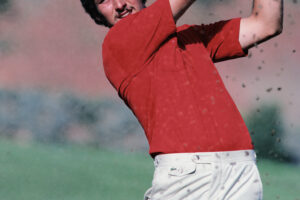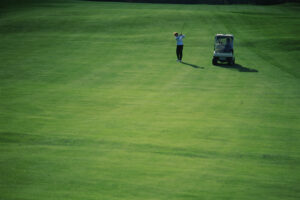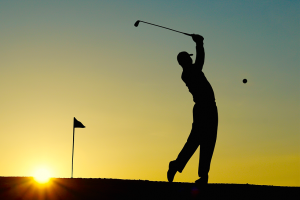Create A Good Rhythm In Your Golf Swing
Rhythm and tempo can be considered together, because in golf they mean very nearly the same thing.
The rhythm in the swing of a good player is noticed because of the measured cadence in the upward and downward movement of the club. In his swing there appears to be and there is a definite relationship in time between his backswing and his downswing.
It is measured in two parts, from the time the club leaves the ball until it stops at the top of the backswing, and from the time it starts to move again until it hits the ball. The club does have to stop at the top, of course, for the instant required to reverse its direction, whether we feel it or realize it or we don’t. No object, not even a golf club, can be traveling in opposite directions at once.
Rhythm In Your Golf Swing
These two segments of the swing can be accurately timed by a motion-picture camera, by the simple process of counting the number of pictures the camera takes during each segment. Such a count shows that the backswing of a good player takes almost exactly twice as long as the downswing.
This two-to-one ratio is the rhythm of the swing. The total time or tempo of the swing will vary with different good players, but the ratio or rhythm will not. Nor will it spot, and many more which are very close to it. This is one of the reasons they hit the ball as far as they do. And one of the reasons they find the sweet spot and get close to it so often, is because their swings are grooved in a constant, unhurried rhythm.
This is why the good player looks so good when he swings at the ball. There seems to be a definite, unhurried, relationship between the two parts of his swing. We sense it if we see him hit the ball only once, and it becomes more and more marked the oftener we see him swing. He has established a definite rhythm and he sticks to it. In fact, one of the things he does when he goes to the practice tee before a round is re-establish his rhythm, so that he hits a 5 iron, for instance, at exactly the same speed, with exactly the same effort, with exactly the same tempo, each time he swings it, whether the shot is simple or difficult.
We will always remember Jimmy Demaret playing the twelfth hole at Inverness in the National Open of 1957. Demaret was in contention and his drive on this hole wound up near the right edge of the fairway. It is a par 5 hole with the first half downhill, the second half uphill. Jimmy’s drive had caught a slight downslope, so that he had a downhill lie. He was standing slightly above his ball. It was a most difficult shot to be made with a wooden club. To reach the green, Jimmy had to use the wood. His swing was as smooth and unhurried as if he had been hitting an 8 iron from a perfect lie to an open green. He hit it with his own established rhythm, and he reached the green with a perfect shot.
Rhythm In Your Golf Swing
The poor or average player has no such established rhythm. Not only does he often have a different rhythm for each club but for different shots with the same club. He is prone to use a 7 and swing faster, when he should be using a 6 with a normal swing. He changes again to dig a ball out of the rough or a bad lie on the fairway. He slows down when he tries to steer the ball. He always speeds up when the situation of the round or match has increased his tension. Most of these changes are noticeable in his backswing, which becomes faster, sometimes almost as fast as his downswing.
This is why his swing looks so bad and the pro’s looks so good.
Why, you may ask, should anyone bother to develop a rhythmic swing? Aside from how it looks, of what value is it?
It has two very definite values. One is that it promotes better timing. It doesn’t assure or guarantee that we will time a shot better, but it helps. It makes good timing easier to achieve.
The second reason is that a rhythmic swing helps a great deal toward the goal of every swing, which is to strike the ball in the exact center of the club face—”on the screws,” as the pros say. There is a very small area on the face, known to all golfers as the “sweet spot,” which transmits the maximum propelling force. When contact is made on this spot, the ball will go much farther than if the contact is toward the club’s heel or toe.
Pertinent here are tests made for the United States Golf Association by the Arthur D. Little Co., a research organization, during the United States Amateur Championship at Brookline in 1957. Pictures were taken of the contact between club and ball. These were compared with the distance attained and with the velocity of the club head at impact.
Among the conclusions drawn by the USGA was that accuracy of contact was highly important in gaining distance. By accuracy was meant contact with the exact center of the club face. Distance dropped, even with a faster swing, if contact was not made precisely at the center.
The average golfer rarely gets this perfect, flush contact, although most of the time he isn’t conscious of not getting it. He thinks of it only when he hits the ball well out toward the toe or in toward the heel, or toward the top or the sole. The pros, on the other hand, hit many shots on the sweet
vary from club to club. The ratio will be the same for the 8 iron as it is for the driver. The tempo of the swing will not change, either, for the individual player.





![golfer-1960998_960_720[1]](https://helpinggolfers.com/wp-content/uploads/2017/11/golfer-1960998_960_7201-300x200.jpg)
![golf-swing-970892_960_720[1]](https://helpinggolfers.com/wp-content/uploads/2017/11/golf-swing-970892_960_7201-300x200.jpg)
![person-1284011_960_720[1]](https://helpinggolfers.com/wp-content/uploads/2017/11/person-1284011_960_7201-300x200.jpg)





Reply